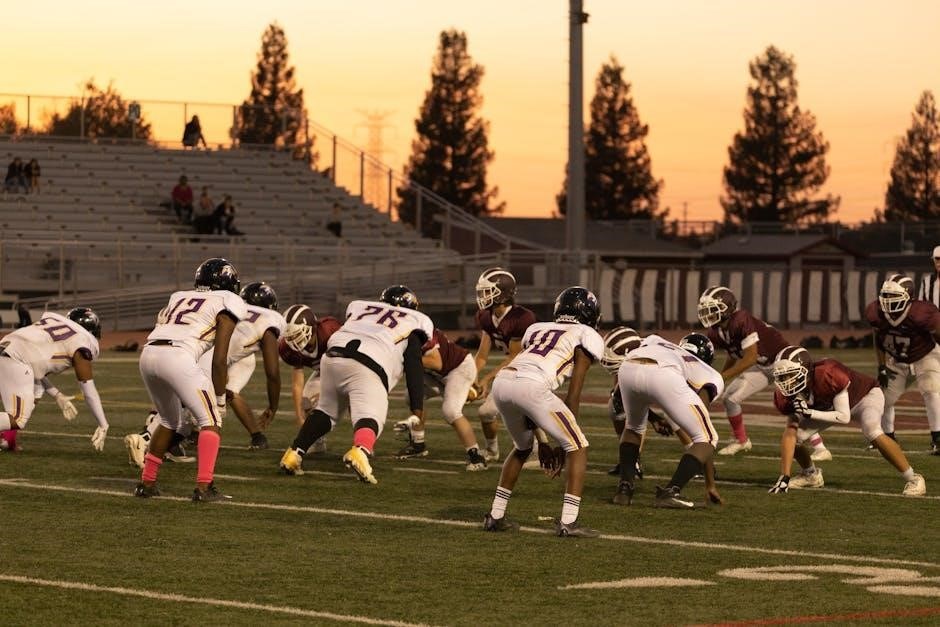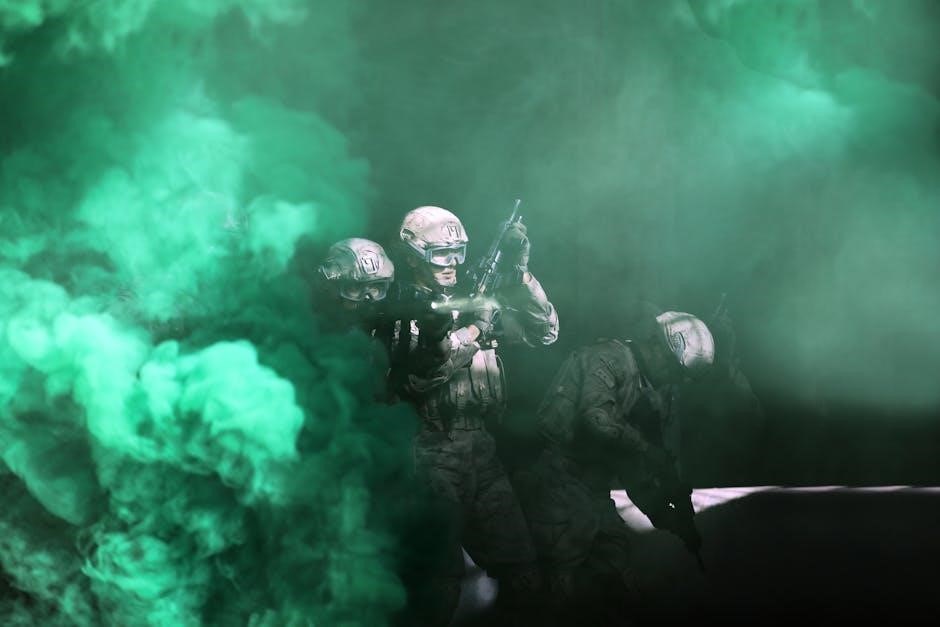The 3-2 zone defense is a tactical basketball strategy designed to create defensive pressure and limit opponents scoring opportunities, positioning three players along the perimeter and two players closer to the basket effectively․
Definition and Purpose
The 3-2 zone defense is a type of defensive strategy used in basketball, characterized by three players positioned along the perimeter and two players closer to the basket․
This formation is designed to disrupt the opponent’s offense and limit their scoring opportunities, by protecting the key and denying passing lanes․
The purpose of the 3-2 zone defense is to force the opposition out of their regular offensive structure and set plays, and to influence poor shot selection, particularly near the perimeter areas of the court․
The 3-2 zone defense is a tactical approach that aims to create defensive pressure and limit opponents’ scoring opportunities, making it a popular choice among coaches․
By understanding the definition and purpose of the 3-2 zone defense, coaches and players can better implement this strategy and improve their team’s overall defensive performance․
The 3-2 zone defense requires a deep understanding of the game and the ability to adapt to different situations, making it a complex and challenging strategy to master․
Effective implementation of the 3-2 zone defense can lead to significant improvements in a team’s defensive capabilities․
Key Characteristics
The 3-2 zone defense has several key characteristics that distinguish it from other defensive strategies, including its unique player positioning and movement․
The three perimeter players are responsible for denying passing lanes and protecting the outside, while the two interior players defend the basket and rebound․
This formation allows for a balanced defense that can protect both the perimeter and the paint, making it difficult for opponents to score․
The 3-2 zone defense also requires a high level of communication and coordination among players, as they must work together to rotate and defend the ball․
Additionally, the 3-2 zone defense involves a significant amount of player movement, as players must shift and adjust to respond to the opponent’s offense․
The key characteristics of the 3-2 zone defense make it a complex and challenging strategy to implement, but also a highly effective one when executed correctly․
By understanding these key characteristics, coaches and players can better implement the 3-2 zone defense and improve their team’s overall defensive performance․

Advantages of 3-2 Zone Defense
The 3-2 zone defense offers several advantages, including enhanced defensive flexibility and protection of the paint effectively always․
Disrupting Opponent’s Offense

The 3-2 zone defense is effective in disrupting the opponent’s offense by forcing them out of their regular structure and set plays, creating uncertainty and confusion among the opposing team’s players․
This is achieved by the three players positioned along the perimeter, who apply pressure on the ball and deny passing lanes, making it difficult for the opponent to initiate their offense․
The 3-2 zone defense also forces the opponent to initiate offense with a skip pass, which can be difficult to execute, especially under pressure․
By disrupting the opponent’s offense, the 3-2 zone defense can limit their scoring opportunities and create turnovers, which can be converted into fast break points․
The defense’s ability to disrupt the opponent’s offense is crucial in gaining a competitive advantage, and the 3-2 zone defense is well-suited to achieve this goal․
Overall, the 3-2 zone defense is a valuable strategy for teams looking to disrupt their opponent’s offense and gain a competitive edge․
Preventing Low Post Scoring
The 3-2 zone defense is designed to prevent low post scoring opportunities by positioning two players closer to the basket, who can protect the paint and defend against low post threats․
This defensive formation allows the team to effectively guard the basket and limit the opponent’s ability to score easily in the paint․
The two players in the low post position can also provide support to the perimeter players, helping to defend against drives and cutters․
By preventing low post scoring, the 3-2 zone defense can force the opponent to take more difficult shots from the perimeter, which can be less effective․
The defense’s ability to protect the paint and prevent low post scoring is crucial in limiting the opponent’s scoring opportunities and gaining a competitive advantage․
The 3-2 zone defense is a valuable strategy for teams looking to prevent low post scoring and defend against opponents with strong post players, making it an effective defensive formation in various game situations․

Disadvantages of 3-2 Zone Defense
The 3-2 zone defense has limitations and drawbacks that teams must consider when implementing this strategy effectively always․
Passive Defense
The 3-2 zone defense is considered a passive defense, which can be a significant disadvantage․ This type of defense allows the opposing team to dictate the pace of the game and control the ball․ The 3-2 zone defense focuses on protecting the paint and preventing low-post scoring opportunities, but it can be vulnerable to outside shooting and dribble penetration․ As a result, the defense can become reactive, responding to the opponent’s movements rather than being proactive and disrupting their offense․ This can lead to a lack of intensity and aggression on the defensive end, making it easier for the opposing team to score․ The passive nature of the 3-2 zone defense can also make it difficult to create turnovers and generate fast-break opportunities․ Overall, the passive defense of the 3-2 zone can be a limitation that teams must consider when implementing this strategy․ Effective execution is crucial to minimize its weaknesses․
Point Position Requirements
The point position in the 3-2 zone defense is a critical component, requiring a player with a high level of understanding and awareness․ This player must be able to read the game and make adjustments on the fly, as they are responsible for covering the top of the key and preventing penetration․ The point player must also be able to communicate effectively with their teammates, directing them to their assignments and ensuring that the defense is aligned properly․ In addition, the point player must be able to move quickly and decisively, as they will be responsible for closing out to shooters and protecting the perimeter․ A player in this position must have a strong understanding of the game and be able to make smart decisions, as they will often be the key to disrupting the opponent’s offense․ The point position requires a unique combination of physical and mental skills, making it a challenging but important role in the 3-2 zone defense․ Effective point play is essential to the success of this defense․

Comparison to Other Zone Defenses
Zone defenses like 2-3 and 1-2-2 are compared to the 3-2 zone defense effectively always․
2-3 Zone Defense
The 2-3 zone defense is a popular choice among coaches, with two players at the top and three players closer to the basket․ This formation is designed to prevent dribble penetration and force the offense to take outside shots․ The 2-3 zone defense is often compared to the 3-2 zone defense, with the main difference being the positioning of the players․ In a 2-3 zone, the two top players are responsible for pressuring the ball and preventing penetration, while the three players closer to the basket protect the paint and rebound․ The 2-3 zone defense is effective in limiting the opponent’s scoring opportunities, but it can be vulnerable to outside shooting․ Overall, the 2-3 zone defense is a solid choice for teams that want to defend the paint and force the opponent to shoot from the outside․ This defense requires good communication and rotation from the players to be effective․
1-2-2 Zone Defense
The 1-2-2 zone defense is another variation of zone defense, with one player at the top, two players in the middle, and two players closer to the basket․ This formation is designed to provide a balance between defending the paint and protecting the perimeter․ The 1-2-2 zone defense is often used to counter teams that have a strong post player, as it provides extra support in the paint․ The two players in the middle are responsible for protecting the high post and preventing passes to the low post․ The two players closer to the basket are responsible for rebounding and defending the paint․ The 1-2-2 zone defense requires good communication and rotation from the players to be effective․ It is also important for the players to be aware of their assignments and to be able to adjust to different situations․ With proper execution, the 1-2-2 zone defense can be an effective way to defend against a variety of opponents․ This defense is also flexible and can be adjusted to fit the needs of the team․